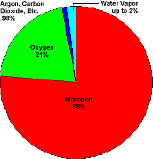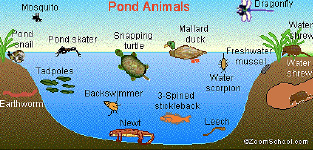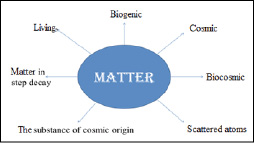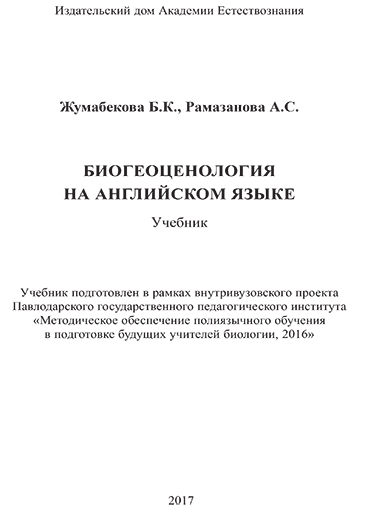
Научная электронная библиотека
Монографии, изданные в издательстве Российской Академии Естествознания
Chapter 3. BIOGEOSPHERE AS ENVIRONMENT FOR LIFE
|
Essential targets: By the end of this chapter you should be able to answer the following questions: What is biogeosphere? What are the features of biogeosphere? How does biogeosphere develop? |
Read the given text. Write out five key words and make collocations with them / Берілген мәтінді оқып шығыңдар. Бес түйінді сөз теріп алып, оларды пайдаланып сөз тіркестерін құрастырыңдар / Прочитайте данный текст. Выпишите пять ключевых слов, и составьте с ними словосочетания.
Historical development of the Biogeosphere
The biogeosphere has undergone a long development over at least 3.5 Ga with drastic changes in the conditions on Earth. These transformations were driven by several factors the most important of which was the evolution of life. The composition of Earth’s atmosphere is currently very different from the reconstructed initial state after formation of the Earth and development of the first organisms (Fig. 4). At the same time the climatic conditions were subject to alterations as the Earth’s energy balance is strongly influenced by the presence of some atmospheric constituents. Life is the key player in the Earth system as it not only continuously alters the global conditions, but has, until now, also been able to adapt itself to the new constraints and to evolve consistently new, higher forms. Recently, man – and especially the modern industrialized civilization – has become an additional driver which has a dramatic impact on global ecosystems and climate at an unprecedented time rate of change [1].

Figure 4. The composition of the atmosphere [2]
Biogeosphere is a wrapper around the globe
Biogeosphere the earth’s envelope in which the living substance of the planet is concentrated. It is situated on the boundary between the surface layer of the earth’s crust and the ocean of air and in the upper part of the water envelope. There are numerous synonyms for “biogeosphere”: layer of concentration of life, film of life (V. I. Vernadsky), biogeocenotic cover (V. N. Sukachev), phytogeosphere (E. M. Lavrenko), epigenema (R. I. Abolin), and vitasphere (A. N. Tiuriukanov and V. D. Aleksandrova). The concept of the earth’s landscape envelope is close in scope to the biogeosphere [1].
Unlike the biosphere, which according to V. I. Vernadsky includes not only the biogeosphere but remote parts of the atmosphere and earth’s crust, the biogeosphere occupies only the region of concentration of living matter; it is a film whose thickness varies from several meters (in the steppes, deserts, and tundras) to tens and hundreds of meters (in forest communities and seas). At the same time, the functioning mass of living matter on a planetary scale is small (about 1/6 x 10-6 of the earth’s mass), but in activity and consequences, according to Vernadsky, it is one of the mightiest geochemical forces on the planet. The structure and activity of the biogeosphere in space are very heterogeneous. Biogeocenosis are elementary units of the biogeosphere (Fig. 5) [1].
The biogeosphere is the only envelope of the earth in which man can remain permanently and carry on normal and many-faceted activity. Man draws almost all his essential resources from the biogeosphere — water, oxygen, fuel, foodstuffs, raw material for industry and building, and so on. The biogeosphere, in turn, is exposed to man’s steadily growing, varied, and profound (including destructive) influences [1].

Figure 5. Animals in the Pond Ecosystem [3]
The Biosphere – Noosphere transition marks the point when the consciousness of the planet goes from the cosmic unconscious to the cosmic conscious. This is a specific geological-evolutionary event-point that coincides with the prophetic cycle: 1987-2013 [4].
This is a pivotal moment in the history of the universe as well. Theologically, it is known as the end of the sixth day of creation, and the beginning of the seventh - or, the Second Creation. Practically, it is referred to as the road to 2012. This refers to the interpenetration of the fourth dimension into the third dimension [4].
This moment was first defined and foreseen jointly by V.I. Vernadsky, the Russian scientist whose geochemical whole systems work defined the biosphere. For both, the Noosphere (mental sheathe of the planet) was the result of a critical point of terrestrial evolution. For Vernadsky, this point is defined by the crisis he called “biogeochemical combustion.” This refers to the impact of industrial technologies and civilization on the resources and cycles of the biosphere bringing it to a fever-pitch of crisis, resulting in a qualitative shift into the Noosphere and the beginning of the psychozoic era [4].
Glossary of essential terms / Негізгі терминдер глоссарийі / Глоссарий основных терминов
|
№ |
English term |
Kazakh equivalent |
Russian equivalent |
|
1 |
consistently |
үнемі |
постоянно |
|
2 |
constraint |
шектеу |
ограничение |
|
3 |
continuously |
үздіксіз |
непрерывно |
|
4 |
currently |
қазіргі уақытта |
в настоящее время |
|
5 |
drastic change |
күрт өзгеруі |
резкое изменение |
|
6 |
earth’s crust |
жер қыртысы |
земная кора |
|
7 |
earth’s landscape |
жер ландшафты |
ландшафт земли |
|
8 |
fuel |
жанармай |
топливо |
|
9 |
geochemical forces |
геохимиялық күш |
геохимическая сила |
|
10 |
global conditions |
ғаламдық жағдай |
глобальное состояние |
|
11 |
initial state |
бастапқы күйі |
начальное состояние |
|
12 |
mighty |
қуатты |
могущественный |
|
13 |
oxygen |
оттек |
кислород |
|
14 |
parts of the atmosphere |
атмосфера қабаты |
слой атмосферы |
|
15 |
planetary scale |
планеталық ауқымы |
планетарный масштаб |
|
16 |
raw material |
шикізат |
сырье |
|
17 |
scale |
ауқымы |
масштаб |
|
18 |
thickness |
жуандық |
толщина |
|
19 |
to influence |
әсер ету |
влиять |
|
20 |
to undergo |
ұшырау |
подвергаться |
|
Questions: What is biogeosphere? What are the features of biogeosphere? What is the basic unit of biogeosphere? What are synonyms of biogeosphere? |
|
Key phrases and sentences / Түйінді сөздер мен сөйлемдер / Ключевые фразы и предложения 1. … is the earth’s envelope in which …/ … жер қабығы, онда …/ … оболочка Земли, в которой … 2. It is located …/ Ол … орналасқан/ Она расположена ... 3. It includes …/ Ол … қамтиды/ Она включает ... |
I. Make a small dialogue on the topic «Biogeosphere» / «Биогеосфера» тақырыбына кіші-гірім диалог құрастырыңдар / Составьте небольшой диалог на тему «Биогеосфера».
II. Make three cinquains with the key words of the text / Мәтіннен алынған үш түйінді сөзден үш синквейн құрастырыңдар / Составьте три синквейна с ключевыми словами из текста.
A cinquain is a five line poem
|
Line 1: |
one word |
|
Line 2: |
two words |
|
Line 3: |
three words |
|
Line 4: |
four words |
|
Line 5: |
one word |
III. Read the given text and make a flowchart. See the examples of flowcharts below / Мәтінді оқып, блок-сызба құрастырыңдар. Блок-сызбалардың үлгісін төменде қараңдар / Прочитайте текст и составьте блок-схему. Посмотрите примеры блок-схем ниже.



The biogeosphere combines the layers of the Earth where life can exist, i.e. the lower atmosphere, the ocean, and soils and sediments that are part of the crust. Smil (2002) has pointed out that living organisms have invaded the entire ocean, most of the atmosphere – with birds reaching altitudes of more than 10 km and microorganisms even the highest layers of the stratosphere – as well as regions below ground, and the deep-ocean floor down to at least 5 km depth. Although the extent of the biogeosphere is remarkable, these few tens of kilometers form only a very thin layer separating the habitable parts of Earth from the hot interior and outer space. The conditions in the biogeosphere are not only determined by the incoming radiation from the Sun (Fin) and the outgoing radiation emitted by Earth’s surface but also very strongly by the existence of life.
IV. Read the article “Vladimir Ivanovich Vernadsky: The Science of the And Biosphere Astrobiology” by Academician M. Ya. Marov [https://www.21stcenturysciencetech.com/Articles_2013/Summer_2013/Biosphere_Astrobiology.pdf]. Write out the main theses of Vernadsky’s theory about Biosphere and living matter / Академик М.Я. Маровтың «Владимир Иванович Вернадский: Биосфера туралы ғылым және Астробиология» мақаласын оқып шығыңдар [https://www. 21stcenturysciencetech.com/Articles_2013/Summer_2013/Biosphere_Astrobiology.pdf]. Вернадскийдің биосфера және тірі зат туралы теориясының негізгі тезистерін теріп, жазып алыңдар / Прочитайте статью “Владимир Иванович Вернадский: Наука о биосфере и Астробиология” академика М.Я. Марова [https://www.21stcenturysciencetech.com/Articles_2013/Summer_2013/Biosphere_Astrobiology.pdf]. Выпишите основные тезисы теории Вернадского о биосфере и живом веществе.
Fill in the table / Кестені толтырыңдар / Заполните таблицу.
Function of living matter of the biosphere
|
Function |
Definition and example |
|
SUMMARY The combination of all the ecosystems of the Earth is a large ecological system is biogeosphere. Biogeosphere is earth geological shell of the planet, which was formed and operates under the decisive influence of living matter, plants, animals, microorganisms. The chemical state of the outer crust of the planet is fully under the influence of biological life. Living organisms his breathing, nutrition, metabolism, by his death and decomposition, the constant use of his substance, continuous generation generate continuous migration and circulation of chemical elements in the Geosphere. |
 Topics for essay:
Topics for essay:
1. The geological history of the planet.
2. Biography of R. I. Abolin.
3. Biography of A. N. Tiuriukanov.
4. Structure and activity of a Biogeosphere.
5. Biography of V. D. Aleksandrov.
6. Biography of E. M. Lavrenko.
7. The current state of biogeosphere.
8. Phytogeosphere as part of the biosphere.
9. Vitasphere as part of the biosphere.
10. Epigennema is surface shell of the Earth.
 References:
References:
1. The free dictionary // http://encyclopedia2.thefreedictionary.com/Biogeosphere
2. The Robinson library // http://www.robinsonlibrary.com/science/physics/meteorology/airgases.htm
3. Tutor Vista // http://www.tutorvista.com/biology/pond-ecosystem-animals
4. Foundation for the law of time // http://www.lawoftime.org/noosphere/transition.html
LABORATORY WORK 1
The theme: Determination of living, non-living and dead things.
The aim: To compare the specimens and determine whether each is living, non-living and dead. Make the conclusion of characteristics of life.
Materials and equipment: rock, potted plant, freshly cut flower in water, freshly cut flower not in water, yeast in warm water and in water bath, oil in water with green food coloring, and in a warm water bath, candle flame, microscope station set up slide of an elodea leaf, microscope station set up with a slide of a wet mount of just water (focus on an air bubble, looks like an amoeba), microscope station set up with a slide of yogurt, mold growing on food, goldfish swimming, cork, apple, package of seeds, germinating seed, loupes.
References: http:// www.stemmom.org
Procedure:
1) List qualities you believe living things must have in order to be classified as “living”. Write the qualities in the first column of the table;
2) Carefully observe the specimens and check off any of the characteristics that you believe that specimen may have;
3) At the bottom of each column, determine the specimen to be Living = L, Non-Living=NL, or Dead=D;
4) Make the conclusion of characteristics of life.
|
Characteristic |
Specimen 1 |
Specimen 2 |
Specimen 3 |
Specimen … |
|
L, NL, D |
Conclusion:
TOPICS FOR SEMINAR
Seminar 1
Chapter 1. Biogeocenology.
1. The main branches of biogeocenology.
2. The practical application of the biogeocenology.
3. The main stages of development of the biogeocenology.
4. The famous scientist of biogeocenology.
Seminar 2
Chapter 2. Biogeosphere.
1. Features of biogeosphere as the shell of the Earth.
2. The limits of the biosphere.
3. Composition of the biosphere.
4. Layers of the biosphere.
5. The concept of the Noosphere.
Seminar 3
Chapter 3. Vernadsky’s theory about Biosphere and living matter.
1. Vernadsky’s career and his important contributions in the science.
2. The biosphere viewed by Vernadsky.
3. Fundamental Features of Life.
4. The main thesis of Vernadsky’s report “On the Conditions for the Appearance of Life on Earth”.
Recommended references:
1. Carl Heintze. The Biosphere: Earth, Air, Fire, and Water // T. Nelson. – 1977. – P. 128.
2. Ian K. Bradbury. The Biosphere // Wiley. – 1999. – № 2. – P. 268.
3. The encyclopedia of Earth // http://www.eoearth.org/
4. Marov M. Ya. Vladimir Ivanovich Vernadsky: The Science of the And Biosphere Astrobiology /https://www.21stcenturysciencetech.com/ Articles_ 2013/ Summer_2013/Biosphere_Astrobiology.pdf.
5. Vernadsky V.I. Problems of biogeochemistry. 2. The fundamental matter-energy difference between the living and the inert natural bodies of the biosphere // Transactions of the Connecticut Academy of Arts and Sciences. – 1944. – Vol. 35. – P. 483-517.
TASKS FOR THE CONTROL WORK 1
1. Match the name and the biography.
|
1. |
Soviet mineralogist and geochemist who is considered one of the founders of geochemistry, biogeochemistry, and of radiogeology, founder of the Ukrainian Academy of Sciences. His ideas of Noosphere were an important contribution to Russian cosmism. |
A |
V. V. Dokuchaev |
|
2. |
Russian geobotanist, engineer, geographer, and corresponding member and full member of the USSR Academy of Sciences. |
B |
V. N. Sukachev |
|
3. |
Russian geologist who is credited with laying the foundations of soil science. He worked on soil science, and developed a classification scheme describing five factors for soil formation. |
C |
V. I. Vernadsky |
2. Using the cluster give the definition of each form of matter.

3. Answer the questions.
1) Who created the doctrine about the biosphere?
2) What is living matter?
3) Give examples of the influence of living matter on the Earth’s shell.
4) What is the importance of nitrogen in plant life?
5) Why the boundary of the biosphere in the atmosphere is at an altitude of 77 km?
4. Translate into English the following words: исследование, значение, взаимосвязанный, влага, частота, сознание, кислород, земная кора, фиксация азота, направление.
5. Fill in the chart «The main components of the biosphere». 
